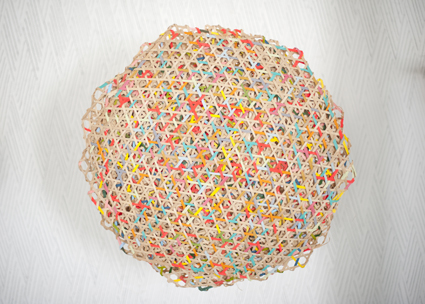Presence, integration & deregulation
Introduction

Zoe Kirkwood, 1) Let Them Eat Cake (detail); 2) The Neo-Baroque Spectacle, installation view.
photos Che Chorley. Zoe Kirkwood, a graduate of the University of SA, is the winner of this year’s Dr Harold Schenberg Art Prize presented at HATCHED National Graduate Show, 2014, PICA, Perth.
Zoe Kirkwood, 1) Let Them Eat Cake (detail); 2) The Neo-Baroque Spectacle, installation view.
Conducting an informal survey of arts education and training for this edition of RealTime has been revealing. It’s striking how university arts faculties and schools are having to establish a public presence in an increasingly competitive market. They’ve been doing this modestly for a long time with open days and hosts of public performances, but the pressure is on as the Abbott Government ‘deregulates’ the tertiary education market.
The second noticeable development is integration, first within degrees—two majors are more frequent, for example directing and design—and across discrete disciplines—double degrees for example media arts and science, dance and law. Secondly, schools are increasingly aligning and partnering themselves with the cultural and creative industries. Jane Montgomery Griffiths (p12) tells us that Monash’s Centre for Theatre & Performance will sponsor Malthouse in a relationship which will benefit their students in attachments with the company. Monash is also holding workshops for the theatre industry featuring prominent overseas artists. Adelaide College of the Arts (p16) enjoys a strong relationship with the State Theatre Company of South Australia and the VCA with a multitude of organisations (p14).
The same kind of integration can be seen in the ‘re-birthing’ of UNSW’s College of Fine Arts as UNSW Art & Design (p6), with local and international partnerships, a significant number of students taking up double degrees, new buildings and facilities. Integration builds public presence.
New and re-visioned degrees are also proliferating, for example VCA’s timely Master of Dramaturgy and SymbioticA’s Master of Biological Art at the University of Western Australia (p22).
If seen as integral to the ‘industry,’ teaching staff play an important role in developing the profiles of tertiary education institutions, not only attracting students but negotiating various partnerships and funded research opportunities.
Unfortunately, for the most part university websites, the key providers of information, are still difficult to negotiate, let alone discover who the teachers are and precisely what courses they teach. Sometimes the information can be found if you’re dogged, but it’s often of varying quality and degree of detail and with little sense of a school’s collective vision—which is most frequently abstractly stated. Similarly, information about graduates varies greatly. Prospective students need to know the who and why of the world they about to enter.

Michael McIntyre, Everything / Becoming A Monster, 2013, Highly Commended, HATCHED Graduate Exhibition, PICA. Image courtesy and copyright the artist.
photo Peter Morgan. Michael McIntyre is a graduate Bachelor of Fine Arts (Painting) (Honours), National Art School, NSW
Michael McIntyre, Everything / Becoming A Monster, 2013, Highly Commended, HATCHED Graduate Exhibition, PICA. Image courtesy and copyright the artist.
Few teachers we communicated with complained about the straitened circumstances of their schools, save for the odd, anxious ‘off the record’ comment about struggling to maintain studio hours and tolerable class sizes and fears of more budget cuts. Surprisingly, given the huge cuts applied to Screen Australia by the Abbott government—what has it got against Australian film?—teachers in film schools were relatively upbeat, extolling to Tina Kaufman (p24) alternative screen career opportunities in the creative industries. While these will provide jobs, they’re not likely to be what many young filmmakers envision for themselves. But the film schools will certainly continue to teach the art of filmmaking with conviction.
Matthew Lorenzon, writing about music education, is concerned about the diminution of opportunities for young musicians to receive the specialist training they warrant, instead they’re expected to become cultural ambassadors for music in whatever roles required (p10). In these circumstances, just getting a job becomes an end in itself.
‘Employability’ is a term favoured by politicians and certain education providers. At its best it means students are prepared to immediately and effectively engage their skills in creative work, at worst it suggests accepting second best—in film because of an utterly unwarranted funding cut. Of course not every screen student or trainee actor will make the grade they seek, but diminished opportunities will undoubtedly limit the realisation of talent.
At the very moment that bridges are being built between the arts and science (and much else) the humanities are clearly, if in varying degrees institution to institution, being devalued in the tertiary education sector, with cuts to TAFE budgets and the whittling down of humanities departments. The blurring and evaporating of the line between the arts and sciences represents a critical moment for our culture, which needs to be regarded cohesively, as a totality in which invention will come from unforeseen collaborations and mergings.
The Dawkins’ reforms of the Labor Government in the late 80s absorbed visual arts, drama, dance and music schools into the academy, giving these forms added legitimacy (as well as hoping for financial savings) but made them subject to university dictates and budgeting with often sorry results. Ironically, however, being part of a university has allowed for the development of multi- and interdisciplinary degrees, pedagogy and research that reflects the state of the arts outside the university. But this great project will come to little if art is regarded as mere presence rather than integral to life.
“Fish are born expecting water, humans are born expecting culture.”
When Michael Tomasello, a developmental psychologist wrote this, he was doubtless thinking of ‘culture’ in the broadest sense, but it applies no less to art as culture: the films and theatre we share, the music we hum, the irrepressible desire to dance, the new live art we make together with which to understand the world.
As essentials to our lives and to our culture, arts education and training within the universities and TAFE need vigorous support against the pervasive neoliberalism that puts a price on everything, converts artists’ visions into business plans and fails to see art as signs of life. We need to defend art in the same way we fight to preserve the diversity of the Earth’s biosphere—because we are part of it and our emotional and physical well-being and survival depend on it.
As for student survival, even though the expected hike in HECS interest rates appears to have been dropped, the Abbott Government proceeds with its fanciful plan to deregulate university fees in order to lower them (and raise TAFE fees?) on the grounds that it will make the sector more competitive. The plan met with this retort from the Sydney Morning Herald’s economics writer Ross Gittins: “To take a relatively small number of government-owned and still highly regulated agencies with a monopoly over credential-granting, allow them to set their own fees and then imagine an adequately competitive ‘market’ would emerge isn’t economics, its magical thinking” (SMH, 4 Aug, 2014).
The wealth of vision, courses, programs and adaptive strategies detailed in the following pages offers more hope than trepidation. RT
RealTime issue #122 Aug-Sept 2014 pg. 5






